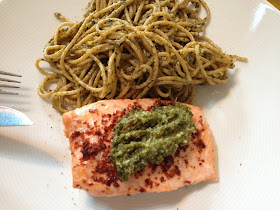This has been an uneven summer for Jersey produce: the tomatoes have been either earthy or woolly; the four ears of corn I have tried so far weren't sweet at all; and I didn't see much in the way of basil until I came across a big bunch this week at the ShopRite in Rochelle Park.
I needed the basil for one of the 101 salads from The Times (see previous posts), but there was so much left, I decided to make my first batch of blender pesto this summer (see recipe below).
For breakfast, I spread the pesto on my toasted 100% whole grain bread from Costco, stuck some fresh basil leaves and cilantro to it, laid on a nice portion of smoked wild salmon, also from Costco, added shavings of Parmigiano-Reggiano cheese and topped that with sliced tomato and za'atar thyme mixture.
The garlicky pesto really elevates that sandwich.
For breakfast, I spread the pesto on my toasted 100% whole grain bread from Costco, stuck some fresh basil leaves and cilantro to it, laid on a nice portion of smoked wild salmon, also from Costco, added shavings of Parmigiano-Reggiano cheese and topped that with sliced tomato and za'atar thyme mixture.
The garlicky pesto really elevates that sandwich.
Blender pesto
(courtesy of Marcella Hazan)
(courtesy of Marcella Hazan)
Place ingredients in the blender in this order:
2 heaping tablespoons of pine nuts (pignoli)
2 large cloves of garlic smashed and peeled, or more to taste
1/2 teaspoon salt
2 cups basil leaves and stems packed (don't skimp on the basil)
3/4 cup of extra virgin olive oil
Start the blender with the top off and push down the basil with a rubber spatula. Stop the blender and push down the leaves on top under the liquid below. Continue blending and pushing until the blades suck down and liquify everything into a thick, flowing mixture. Empty into a bowl. At this point, you can freeze the pesto in a plastic container for later use. When thawed, add:
3/4 to 1 cup of grated Parmigiano-Reggiano cheese, or more to taste, and blend in with a fork or spoon.
You can use another cheese, such as pecorino romano. Pesto does not require heating. Use as a sandwich spread, put a big spoonful on top of cooked fish or meat, or add to 1 pound of pasta, preferably penne, medium shells or other small pasta, cooked al dente. You can garnish the pasta with more pine nuts and sun-dried tomatoes or not.
Pesto originated in Genoa, Italy, where they add sliced, boiled potatoes to their pasta pesto. I was introduced to it in the early 1970s and I have never tired of it. My first taste each summer, and every taste, is a delight.

No comments:
Post a Comment
Please try to stay on topic.